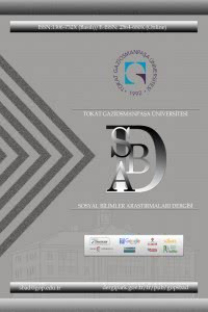Temel Yetkinliklerin Belirlenmesine Yönelik Süreç ve Model Önerisi (Vaka Çalışması)
Bu çalışmada temel yetkinlikleri belirleme süreci ve temel yetkinlik modeli önerilmektedir. Çalışma İstanbul’da faaliyet gösteren bir şirketler topluluğunda gerçekleştirilmiştir. Çalışma için öncelikle pilot bir şirket belirlenmiştir. Odak grup çalışmasına pilot şirketin üst yönetimi, bölüm yöneticileri, insan kaynakları profesyonelleri ve danışmanlar katılmıştır. Model geliştirme çalışması tüm çalışanlarla yapılan anketle sonlandırılmıştır. Çalışma ile kurumun değerlerini yansıtan 20 temel yetkinlik belirlenmiştir
Anahtar Kelimeler:
Temel yetkinlikler, Temel yetkinlik modeli, Yetkinlik geliştirme süreci
A Process and Model Suggestion for Determining Core Competencies (A Case Study)
This article presents a detailed process and a model for core competencies. The study tested the development of core competency model at a group of companies in Istanbul. At the very beginning a pilot firm is selected for the study. The focus group study was carried out in partnership with the firm’s top executives, line managers and human resource professionals and consultants. The model was completed with a survey among all incumbents. The core competency model consists of 20 competencies representing core values of the company
___
- Athey, T.R., Orth, M.S. (1999), “Emerging Competency Methods for the Future”, Human Resource Management, 38(3), 215-226.
- Biçer, G. ve Düztepe, Ş. (2003), “Yetkinlikler ve Yetkinliklerin İşletme Açısından Önemi”, Havacılık ve Uzay Teknolojileri Dergisi, 1(2), 13- 20.
- Brockbank, W., Ulrich, D. ve Beatty, R. W. (1999), “HR Professional Development: Creating the Future Creators at the University of Michigan Business School”, Human Resource Management, 38(2), 111–117
- Budak, G. (2008), Yetkinliğe Dayalı İnsan Kaynakları Yönetimi, 1. Baskı, İzmir, Barış Yayınları.
- Capaldo, G., Iandoli, L. ve Zollo, G. (2006), “A Situationalist Perspective to Competency Management”, Human Resource Management, 45(3), 429- 488.
- Cardy, R.L., Selvarajan, T.T. (2006), “Competencies: Alternative Frameworks for Competitive Advantage”, Business Horizons, 49, 235-245.
- Chung-Herrera, B.G., Enz, C.A. ve Lankau, M.J. (2003), “Grooming Future Hospitality Leaders: A Competencies Model”, Cornell Hotel and Restaurant Administration Quarterly, 44(3), 17-25.
- Conway, C. (1994), “Developing Senior Management Competencies at Ocean Group”, Management Development Review, 7(1), 7-12
- Currie, G., Darby, R. (1995), “Competence-based Management Development: Rhetoric and Reality”, Journal of European Industrial Training, 19(5), 11-18
- Çelikkol E.S., Uçkun, C.G., Tekin, V.N. ve Çelikkol, Ş. (2012), “Türkiye’de İç Hatlardaki Havayolu Taşımacılığında Müşteri Tercihi ve Memnuniyetini Etkileyen Faktörlere Yönelik Bir Araştırma”, 4(3), 70- 81
- Çetinkaya, M. (2009), “Yöneticilerin Yönetsel Yetkinlik Algılamalarına İlişkin Bir Araştırma”, Afyon Kocatepe Üniversitesi İ.İ.B.F. Dergisi, 11(2), 219-238.
- Deist, F.D. ve Winterton, J. (2005): “What is Competence?”, Human Resource Development International, 8:1, 27-46.
- Dessler, G. (2007), Human Resource Management, 11 Baskı, New Jersey, Pearson Prentice Hall.
- Enis, M.E. (2008), Competency Models: A Review of the Literature and The Role of the Employment and Training Administration (ETA), http://www.careeronestop.org/COMPETENCYMODEL/info_document s/OPDRLiteratureReview.pdf, (10.11.2012)
- Gangani, N., McLean, G.N., Braden, R.A. (2006), “A Competency-Based Human Resource Development Strategy”, Performance Improvement Quarterly, 19(1), 127-140.
- García-Barriocanal, E., Sicilia, M.A. ve Sánchez-Alonso, S. (2012), “Computing with Competencies: Modelling Organizational Capacities”, Expert Systems with Applications 39, 12310–12318.
- Heinsman, H. (2008), The Competency Concept Revealed: Its Nature, Relevance, and Practice, Academisch Proefschrift, Vrije Üniversitesi, PrintPartners Ipskamp BV, Enschede, http://dare.ubvu.vu.nl/bitstream/1871/ 13216/5/7960.pdf, (22.10.2012).
- HR-XLM, (2001), Competencies 1.0 (Measurable Characteristics) Recommendation 2001, Der: Chuck Allen, http://xml.coverpages.org /HR-XML-Competencies-1_0.pdf, (22.10.2012)
- IDAS, (2006), Competency Guide, Iowa Department of Administrative Service Human Resource Enterprise, http://das.hre.iowa.gov/documents/ class_and_pay/competency_guide.doc, (22.10.2012)
- Kalaycı, Ş. (2008), SPSS Uygulamalı Çok Değişkenli İstatistik Teknikleri, 3. Baskı, Ankara, Asil Yayın Dağıtım.
- Klink, M., Boon, J. (2002), “The Investigation of Competencies within Professional Domains”, Human Resource Development International, 5(4), 411-424
- Lahti, R.K. (1999), “Identifying and İntegrating İndividual Level and Organizational Level Core Competencies”, Journal of Business and Psychology, 14(1), 59-75.
- Leyking, K., Angeli, R., Ag, I. S. (2009), “Model-based, Competency-Oriented Business Process Analysis”, Enterprise Modelling and Information Systems Architecture Journal, 4(1), 14-25.
- Mansfield, R. S. (2000). “Practical Questions for Building Competency Models”, Competency-Based Management for the Federal Public Service Conference. Ottawa, Canada, 3-17, www.lexonis.com/resources/ practical%20questions%20building%20models.pdf. (05.11.2012)
- McClelland, D.C. (1973), “Testing for Competence Rather than for Intelligence”, American Psychologist, (Ocak), 1-14.
- Nordhaug, O. ve Grenhaug, K. (1994), “Competences as Resources in Firms”, The International Journal of Human Resource Management, 5(1), 89- 106.
- Özçelik, G., Ferman, M. (2006), “Competency Approach to Human Resources Management: Outcomes and Contributions in a Turkish Cultural Context”, Human Resource Development Review, 5(1), 72-91.
- Özden, C., Başarılı Bir Hayat İçin Kariyer Planlama Yöntemi, Yayın no: 25, İstanbul, Ödül Yayınları.
- Petersen, S.A., Heikurs, T., Cerinŝek, G. ve Bedek, M. (2011), Competence Portfolios, European Commission Seventh Framework Project (IST 231717), http://www.reachyourtarget.org/joom”la/attachments/article/156 /D4.1%20Competence%20Portfolios,%20v.%202.pdf, (10.11.2012)
- Rodriguez, D., Patel, R., Bright, A., Gregory, D. and Gowing, M.K. (2002), “Developing Competency Models to Promote Integrated Human Resource Practices”, Human Resource Management, 41(3), 309-324.
- Saylı, H., Ağca, V. (2009), “Bilgi Çağı İşgörenlerinin Değişen Yetkinlikleri ve İşletmelerin Yetkinlik Beklentilerini Belirlemeye Yönelik Bir Alan Araştırması”, Selçuk Üniversitesi İİBF Sosyal ve Ekonomik Araştırmalar Dergisi ,11(17) 345-364
- Tak, B., Sayılar, Y. ve Kaymaz, K. (2007), “Yetkinliklere Dayalı İnsan Kaynakları Yönetimi ve Ücretlendirme Sistemi Üzerine Bir İnceleme”, İşletme Fakültesi Dergisi, 8(2), 233-266.
- Ulrich, D. (1998), “Intellectual Capital =Competence x Commitment”, Sloan Management Review, 39(Winter), 15-26.
- Yeung, A. K. (1996), “Competencies for HR Professionals: An Interview with Richard E. Boyatzis”, Human Resource Management, 35(1), 119-131.
- ISSN: 1306-732X
- Yayın Aralığı: Yılda 2 Sayı
- Başlangıç: 2006
- Yayıncı: Gaziosmanpaşa Üniversitesi Sosyal Bilimler Enstitüsü
Sayıdaki Diğer Makaleler
Türkiye’de Mali Kural Uygulamaları ve Bu Uygulamaların Vergi Gelirleri Üzerindeki Etkileri
Doğan BOZDOĞAN, Selçuk BUYRUKOĞLU
M Cevat YILDIRIM, Abdurrahman EKİNCİ
Avrupa Birliği ve Türkiye’de Yaş Meyve ve Sebze Pazarlama Sistemleri
Çocukları Okul Öncesi Eğitim Kurumlarına Devam Eden Velilerin Önem Verdikleri Kurum Özellikleri
Temel Yetkinliklerin Belirlenmesine Yönelik Süreç ve Model Önerisi (Vaka Çalışması)
İbn Kemâl’in Bir Gazelinin Şerhi ve Ses Tekrarları Açısından Değerlendirilmesi
Para Politikası Araçlarının Ekonomiyi Yönlendirmede Kullanılması: Azerbaycan Örneği
